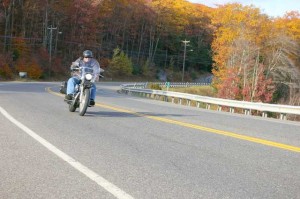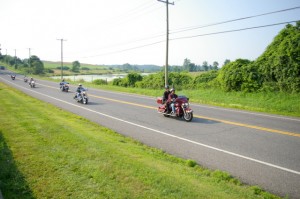By Steve Smith of RIDE-CT.com
 Have you met someone who seems to have a sixth sense when it comes to riding in traffic? These folks just seem to know when there will be trouble ahead. These riders have strong “situation awareness.” Situation awareness is the perception of potential hazards and factors that could lead up to a crash.
Have you met someone who seems to have a sixth sense when it comes to riding in traffic? These folks just seem to know when there will be trouble ahead. These riders have strong “situation awareness.” Situation awareness is the perception of potential hazards and factors that could lead up to a crash.
More often than not, riders are involved in crashes that might have been prevented if they were more aware. Most motorcycle safety courses teach that there is rarely a single cause of a crash. In the Basic Rider Course, we educate riders that most times it’s an interaction of factors that come together in such a way that leads up to a crash situation.
The curriculum material says you should ask yourself three questions before heading out: 1) Are you mentally and physically ready? 2) Is your bike ready ? 3) Is your gear ready?
Motorcycling is said to be more eyes and mind, rather than hands and feet. It’s the mental skills we learn and put into practice that will increase our situational awareness. Because riding a motorcycle requires so much of our attention it is important that we are mentally prepared to ride and be alert.
Being well-rested, clear-headed, and not under the influence of any medications or alcohol is very important. We need to remain undistracted and focused on riding, to scan and observe well ahead, and to develop 360 degree awareness.
Learning to see and assess potential trouble is how we begin to obtain situation awareness. Riders should be scanning ahead as well as all around. Become adept at looking for the obvious and not so obvious. Think ahead and have a plan in case something you noticed becomes a hazard.
For instance, you see children playing ball in a front yard ahead. What would happen if the ball rolls into the street and a child darts after it? You see a car waiting to pull out of a coffee shop parking lot ahead. What if the driver does not see you or gets distracted? What about that curve ahead? Can you see the exit so you know there are no hazards around  the bend? Have you set up a proper entry speed that allows safe cornering? Stay to the outside when entering turns to get the best view ahead. An outside-inside-outside path through turns will help make the it easier to negotiate.
the bend? Have you set up a proper entry speed that allows safe cornering? Stay to the outside when entering turns to get the best view ahead. An outside-inside-outside path through turns will help make the it easier to negotiate.
Use lane position to provide better view of traffic ahead and also so that traffic sees you. Remember that intersections are the most common place for a crash with other traffic. That coffee shop driveway is an intersection, so stay alert. Sometimes making eye contact with the driver is an indication they see you – but maybe not. Watch the tires and wheels of the stopped vehicle. You will more easily see rotational movement before forward movement that may clue you in if the vehicle will pull out into your way.
Also give consideration to the machine you are riding and its limitations. Older and vintage bikes do not have the braking capabilities of more modern machines. Be sure to give yourself more time and space to perceive and react to hazards. Understand the traction limitations of your machine, and that traction is shared between driving force, turning, and braking. This shared traction can severely complicate braking in a turn.
 Riding in groups or with passengers have other considerations and these are topics unto themselves. Here are a few tips. When riding with passengers braking distances and acceleration time are increased. Passengers can affect handling, so it is a good idea to provide some instruction to your passenger. In group riding, use a staggered formation with at least a 2 second following distance between riders. Ride your own ride – don’t let the herd mentality or ego get you riding over your head.
Riding in groups or with passengers have other considerations and these are topics unto themselves. Here are a few tips. When riding with passengers braking distances and acceleration time are increased. Passengers can affect handling, so it is a good idea to provide some instruction to your passenger. In group riding, use a staggered formation with at least a 2 second following distance between riders. Ride your own ride – don’t let the herd mentality or ego get you riding over your head.
Last thing is to do a gear check and please wear proper protective gear. Sweat washes off a whole lot easier than road rash. Use a quality helmet manufactured to DOT standards or one that is SNELL approved, and wear a riding jacket, pants, full fingered leather gloves, and sturdy, over the ankle footwear.
 Ride CT & Ride New England Serving New England, NYC and The Hudson Valley!
Ride CT & Ride New England Serving New England, NYC and The Hudson Valley!


